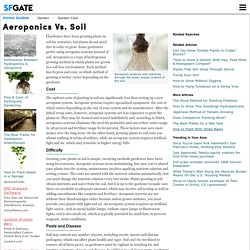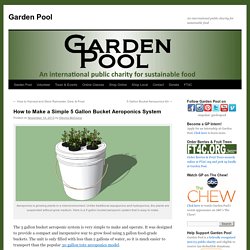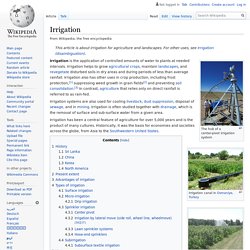

Aeroponics Vs. Soil. Gardeners have been growing plants in soil for centuries, but plants do not need dirt in order to grow.

Some gardeners prefer using aeroponic systems instead of soil. Aeroponics is a type of hydroponics growing method in which plants are grown in a soil-less environment. Each method has its pros and cons, so which method of growing is better varies depending on the gardener. Cost The upfront costs of planting in soil are significantly less than setting up a new aeroponic system. Difficulty Growing your plants in soil is simple, involving methods gardeners have been using for centuries. Pests and Disease Soil may contain any number of pests, including weeds, insects and disease pathogens, which can affect plant health and vigor. Growth and Vigor Aeroponic systems allow you to grow your plants in a controlled environment, which ensures they receive optimum temperatures, light, nutrients and air. Photo Credits Martin Poole/Photodisc/Getty Images. Survival Food Series: 25 Survival Seeds You Need For Your Garden.
Living off the land sounds as inviting as Christmas dinner.

But many have hardly had adequate experience being “farmers.” In fact, many have had no experience at all when it comes to planting anything. That being said, the day is slowly approaching where each of us may have to trade in our company identification badges for a shovel and a pair of overalls. Educating yourself on farming topics such as mirco farming, planting for the seasons, natural insect repellents, seed collection and seed storage could help prepare for an upcoming economic crisis. Learn about how many vegetables or fruits the plant will yield. Start Practicing The only way to be fully prepared as far as growing plants is concerned is to practice, practice, practice. With each gardening experience will come more wisdom on how to handle a larger garden. Survival Seeds. Earthship Biotecture - Radically Sustainable Buildings. How to Build a Totally Self-Sustaining Home. More than four decades ago, a lone architect had what must have seemed at the time like an impossible dream: to build a new kind of residence that would be in complete harmony with the planet.

This home would be made with recycled and sustainable materials. It would rely on clean energy and renewable resources to supply its inhabitants with the most basic and essential of needs. It would be designed to be affordable and utilize construction techniques that are so simple that anyone could build it. This vision was the beginning of what is now known as the Earthship – a remarkable feat of sustainable living. The environmental, economical, and ethical reasons for living in an Earthship – or any self-supporting home for that matter – are abundant. Four Walls and a Roof Despite the fact that the size of the average American family has shrunk from 3.3 people per household in 1960 to 2.54 in 2014, the demand for larger homes continues to grow. Electricity Water & Waste Management Food.
How to Make a Simple 5 Gallon Bucket Aeroponics System. Aeroponics is growing plants in a mist environment.

Unlike traditional aquaponics and hydroponics, the plants are suspended without grow medium. Here is a 5 gallon bucket aeroponic system that is easy to make. Irrigation. The hub of a center-pivot irrigation system Irrigation systems are also used for cooling livestock, dust suppression, disposal of sewage, and in mining.

Irrigation is often studied together with drainage, which is the removal of surface and sub-surface water from a given area. Irrigation has been a central feature of agriculture for over 5,000 years and is the product of many cultures. Historically, it was the basis for economies and societies across the globe, from Asia to the Southwestern United States. History[edit] Animal-powered irrigation, Upper Egypt, ca. 1846 Archaeological investigation has found evidence of irrigation in areas lacking sufficient natural rainfall to support crops for rainfed agriculture. The Ancient Nubians developed a form of irrigation by using a waterwheel-like device called a sakia. Sri Lanka[edit] China[edit] Korea[edit] North America[edit] Irrigation ditch in Montour County, Pennsylvania Present extent[edit] Water gardens in sigiriya Advantages of irrigation[edit]